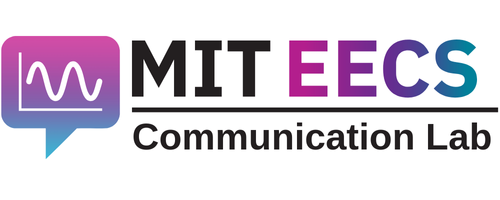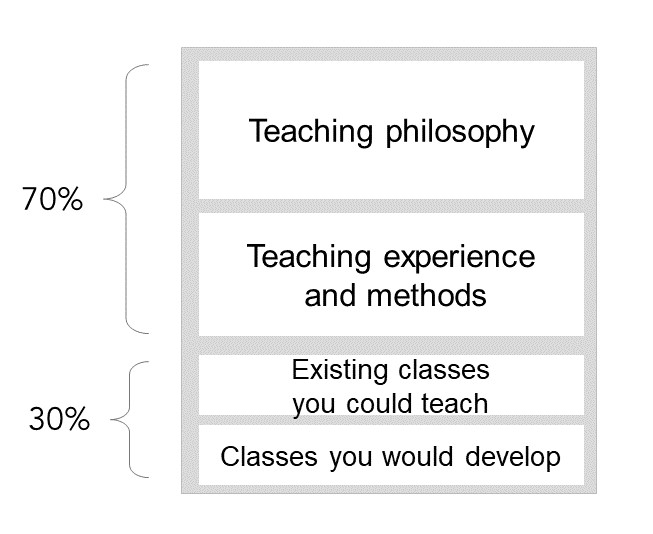Criteria for Success
Your teaching statement should…
- Describe how you think about teaching (ie, your teaching philosophy).
- Show your teaching experience, including but not limited to courses, workshops, and seminars, and connect your experience to how you will teach in the future.
- Demonstrate match with the needs and curriculum of the department to which you are applying.
- Include existing and new classes you are prepared to teach.
- Avoid typos and errors.
Structure Diagram
A teaching statement – sometimes called a teaching philosophy statement – generally does not have a prescribed structure. Section headings are not required but may be used to help organize the document. If specific instructions are given in the job posting, be sure to follow the guidelines for content, structure, format, and length. Unless otherwise specified, the typical length of a teaching statement for an EECS faculty application is around two pages.
Whatever structure you use, a teaching statement should include the following components: 1) your teaching philosophy (that is, how you think about being a teacher both in and out of the classroom), 2) your teaching experiences and methods, and 3) existing classes you are interested in teaching and future classes that you would develop. We recommend using a structure similar to that in the diagram below.
Identify Your Purpose
A teaching statement should do more than reiterate the Teaching Experience section of your CV. It should explain how you approach teaching, highlight your teaching capabilities and experience, and demonstrate a match with the department to which you are applying. Your teaching statement should work with the rest of your application to demonstrate your branding statement. The overall goal of a teaching statement is to demonstrate that you are ready and qualified to carry out the teaching responsibilities of a professor.
Analyze Your Audience
As with all components of a faculty application, the audience for a teaching statement is the faculty search committee. In particular, Education Officers and other faculty who are deeply invested in teaching are the most likely to read your teaching statement in depth. Your statement should be customized based on the curriculum and needs of your target institution in order to demonstrate that you are a good fit for the teaching needs of the department you are applying to.
Skills
Demonstrate how you think about teaching and learning
Your teaching statement should demonstrate how you think about teaching and learning – that is, your teaching philosophy. There is no need to reinvent the wheel; in fact, deviating too much from standard teaching methods is usually frowned upon. While there is no one best way to teach, there is a large body of literature describing effective teaching methods. Whether you draw from this literature, your own experience, or (ideally) a combination of the two, you should clearly outline what you think makes for effective teaching and what educational principles are important to you.
Your teaching statement, like the other parts of your faculty application package, should align with your branding statement. For example, if your research is at the intersection of theory and practice, your teaching methods could also stress this convergence. If applicable, you can also suggest examples for how to link your research and teaching through projects, problem sets, or other means.
You may wish to extend the teaching statement to discuss your impact as a teacher beyond the classroom. Consider other interactions with students including office hours and discussions outside of class. You may also discuss your mentorship style and experiences. When doing so, show your impact on students, which may include papers you published with them, awards, new projects and research directions, or a mentee’s success after graduation.
Support your teaching philosophy with concrete experiences and methods
While it is important to describe your teaching philosophy in your teaching statement, it is not sufficient to only do this in an abstract way. Your teaching philosophy should be supported by concrete experiences and classroom practices. Whether you are describing how you have taught in the past or how you will teach in the future, be specific and realistic. Give a clear picture of what students in your classroom will experience by being specific about techniques you will use, but avoid using jargon that is known only to people in your subfield or to formally trained educators.
When possible, explain how your past teaching experiences, whether formal or informal, have demonstrated your teaching philosophy. When you describe teaching experience, wherever possible, quantify and concretize these experiences – for example, how many class sessions you taught, how many students were in each class, or how many quizzes or problem sets you designed. You can also provide information from teaching evaluations or quote a student’s feedback about your teaching style or methods. When writing about a specific student, avoid mentioning their name or other identifying information if possible.
Leverage every possible teaching-related experience in your statement. Teaching doesn’t only mean standing at the front of a classroom and lecturing. Teaching-related experiences can include tutoring, workshops, seminars, mentoring, outreach events, volunteering, and more. All of these experiences and methods can help to make your teaching philosophy concrete and demonstrate that you are prepared to teach. They can also help you reflect on what you have learned over time, what worked well and what didn’t, and how you overcame challenges.
Especially if you don’t have much teaching experience, you can also demonstrate a growth mindset in your statement. Write about professional development courses or demonstrate a history of getting and implementing as much feedback as possible to highlight this mentality. Demonstrate knowledge of where you can go for help by doing some research into what teaching support is offered at the institution to which you are applying. An internet search for “[Institution Name] teaching center” can usually help to identify these resources. Simply, show how you have grown and will continue to grow over time and what you can offer as a teacher.
Regardless of how much teaching experience you have, your teaching statement should describe techniques and methods you will utilize in your future classes to be an effective teacher. Mention examples of classroom activities you will use and specific learning objectives you have for your students. Describe what kind of classroom environment you are striving for and elaborate on techniques you will use to create that environment in an engaging way.
Present a concrete, flexible, department-specific teaching plan
While the teaching philosophy and experiences you present in applications to different institutions are unlikely to change drastically, your statement should be tailored to demonstrate how you would fit into the department where you are applying. In addition to reflecting your branding statement, classes that you propose to teach should align with the existing curriculum of the department. Information about courses offered is usually available on a department’s website.
Demonstrate that you are able to help meet the needs of the department. To do this, list both classes that already exist at the institution that you would be able to teach and a few classes (undergraduate or graduate) you could develop to fill gaps in the curriculum. In order to suggest classes effectively, you will have to do some research into the curriculum at your target institution. The names and levels of existing classes may differ depending on the institution. The curriculum gap and the needs of the department may differ as well. Be careful not to propose the development of an already established course.
It is often difficult to know what classes are currently understaffed and what classes may already be in development. To avoid insulting anyone in the department, your suggestions should be concrete but flexible. Use language that suggests you are “prepared” or “willing” to teach or develop certain classes rather than stating what you “will” teach in the department.
MIT EECS affiliates can make an appointment with a Communication Fellow to obtain feedback on any part of their faculty application package.

